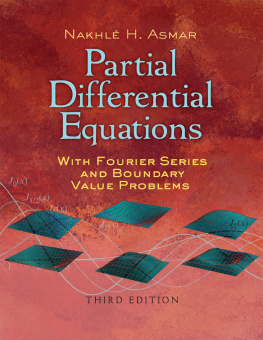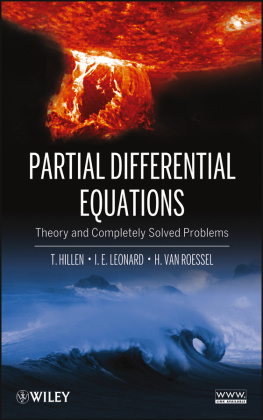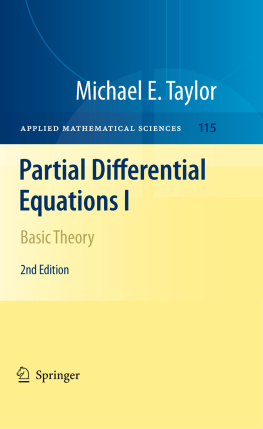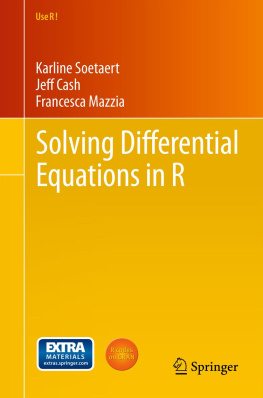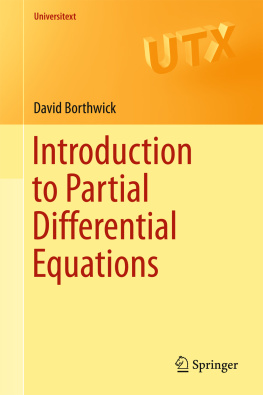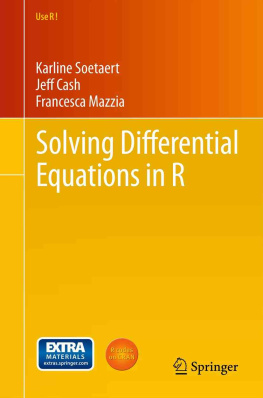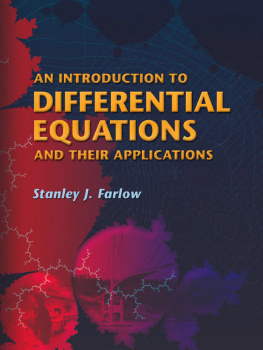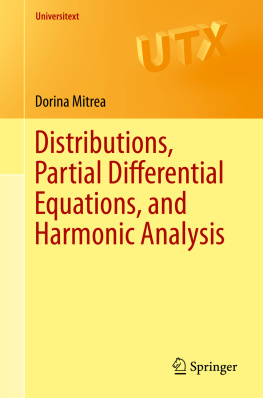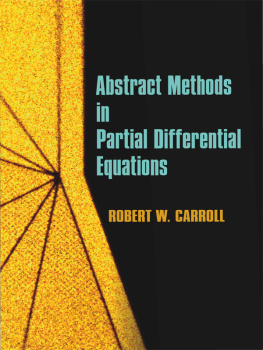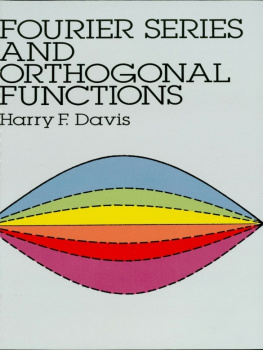PARTIAL DIFFERENTIAL EQUATIONS
with FOURIER SERIES and BOUNDARY VALUE PROBLEMS
NAKHL H. ASMAR
University of Missouri
To the memory of my mother Mounira Asmar
-NHAContents
Supplement on ConvergenceSupplement on Bessel FunctionsSupplement on Legendre FunctionsSupplement on Orthogonal PolynomialsAPPENDIXES
Preface
This book is intended as a modern textbook for an introductory course on partial differential equations and boundary value problems, including Fourier series. It is designed for use by students who have completed a first course in ordinary differential equations.
The Books Content and Organization The book is so organized as to provide a smooth transition from a course in elementary ordinary differential equations to more advanced topics in a first course in partial differential equations. Even though the book is intended for students of engineering, mathematics, and physics, with heavy emphasis on applications, the new topics in this edition offer the instructors the option to teach a theory oriented course on partial differential equations or a course with heavier emphasis on Fourier series and boundary value problems. Beyond the core material for a basic course on partial differential equations (see Possible Course Outlines, below), the book includes a number of more specialized topics that the instructor can cover or use as research projects at his or her discretion.
These more advanced topics, while building on the core material, are more or less independent of each other. Minimal Prerequisites In we review the basics from the theory of linear ordinary differential equations, including series methods. This material may be covered in detail or completely omitted at the discretion of the instructor. It is included as a convenience to the student who wishes to review these topics and to have ready access to them. In particular, Sections A.4A.6 contain a detailed treatment of the power series method and the Frobenius method that is suitable for students who are seeing this material for the first time. The Exercises and Noteworthy Features for Computer Users Each set of exercises begins with a series of straightforward problems designed to solidify the students understanding of the basic concepts in that section. The Exercises and Noteworthy Features for Computer Users Each set of exercises begins with a series of straightforward problems designed to solidify the students understanding of the basic concepts in that section.
The later exercises in each section are usually more involved and lead the student to a deeper understanding of the concepts. They usually include detailed hints to make them accessible to all students at this level. Some sections contain Project Problems which are longer exercises geared toward noteworthy results or interesting applications. They can be used by individual students, or as group projects, or as further illustrations by the instructor. While the book is written from a traditional viewpoint and is suitable as a textbook without computer access, I have included several examples and exercises that make use of the computer. Exercises that require the use of the computer are preceded by a computer icon.
Typically these exercises ask the student to investigate problems using computer-generated graphics (e.g., convergence of partial sums of Fourier, Bessel, Legendre, and other expansions in terms of special functions), and to generate numerical data that cannot be computed by hand with a reasonable effort (for example, computing generalized Fourier coefficients and roots of transcendental equations). Possible Course OutlinesBasic Course in Partial Differential Equations. This course consists of the core material. . . as needed). as needed). . as needed). A Course with an Emphasis on Engineering Applications. A Course with an Emphasis on Engineering Applications.
Substitute the material from . A Course with an Emphasis on Physics. Substitute sections from . A Course with an Emphasis on Mathematical Proofs. Include . The Companion Web Site The authors Mathematica files and a Student Solutions Manual, as well as other complementary material related to the book, can be downloaded from the authors web site at http://www.math.missouri.edu/nakhle Instructors wishing to obtain an Instructor Solutions Manual can contact the author directly by e-mail at Acknowledgments I wish to thank Professor Stephen Montgomery-Smith (University of Missouri) for his friendship and for contributing many great ideas that I incorporated in this book. The Companion Web Site The authors Mathematica files and a Student Solutions Manual, as well as other complementary material related to the book, can be downloaded from the authors web site at http://www.math.missouri.edu/nakhle Instructors wishing to obtain an Instructor Solutions Manual can contact the author directly by e-mail at Acknowledgments I wish to thank Professor Stephen Montgomery-Smith (University of Missouri) for his friendship and for contributing many great ideas that I incorporated in this book.
I also wish to thank the following reviewers and users of my textbook who have generously shared with me several insightful ideas and comments: Professors Alexander M. Balk (University of Utah), Gang Chen (Xian Jiaotong University, China), Mark W. Coffey (University of Colorado), Stefanos Folias (University of Alaska), Richard Ford (California State University), Stephen J. Greenfield (Rutgers University), Gerd Grubb (Copenhagen University, Denmark), Grant Gustafson (University of Utah), Grant W. Hart (Brigham Young University), Jonathan Hostgaard-Brene (The Technical University of Denmark), Robert B. Israel (University of British Columbia), Mark Kon (Boston University), Mark Lammers (University of North Carolina), James Moore (University of Utah), David G.
Retzloff (University of Missouri), Atanas Stefanov (University of Kansas), Saleem Watson (California State University), Darryl Yong (Harvey Mudd College), Jun Yu (University of Vermont). I am especially thankful to Professor Alistair Windsor (University of Memphis) for sending me his precious comments and corrections and allowing me to use them in this edition. Many thanks to Professor Ghazi Asmar (Notre Dame University, Lebanon) for his help on . I am very grateful to Professors Sharon Lubkin (North Carolina State University) and Matt Insall (Missouri S&T) for their encouragements to republish the book. I am especially grateful for the support that I received from my family and my parents. Nakhle H. Nakhle H.
Asmar
1
A PREVIEW OF APPLICATIONS AND TECHNIQUES
Topics to Review This chapter is self-contained and requires basic knowledge from calculus, such as partial derivatives. We make occasional references to topics from a first course in ordinary differential equations. These topics are found in and can be called on as needed.
Looking Ahead This chapter is intended to introduce some of the basic notions occurring in the study of partial differential equations and boundary value problems. and the other more systematic developments to follow.
Everything should be made as simple as possible, but no simpler. ALBERT EINSTEIN Partial differential equations arise in modeling numerous phenomena in science and engineering.
In this chapter we preview the ideas and techniques that will be studied in this book. Our goal is to convey something of the flavor of partial differential equations and their use in applications rather than to give a systematic development. In particular, by focusing on the vibration of a stretched string, we will see how partial differential equations arise in modeling a physical phenomenon and how the interpretation of their solutions helps us to understand this phenomenon. The chapter will culminate with a brief discussion of Fourier series that highlights their importance to the development of the applications of partial differential equations.

